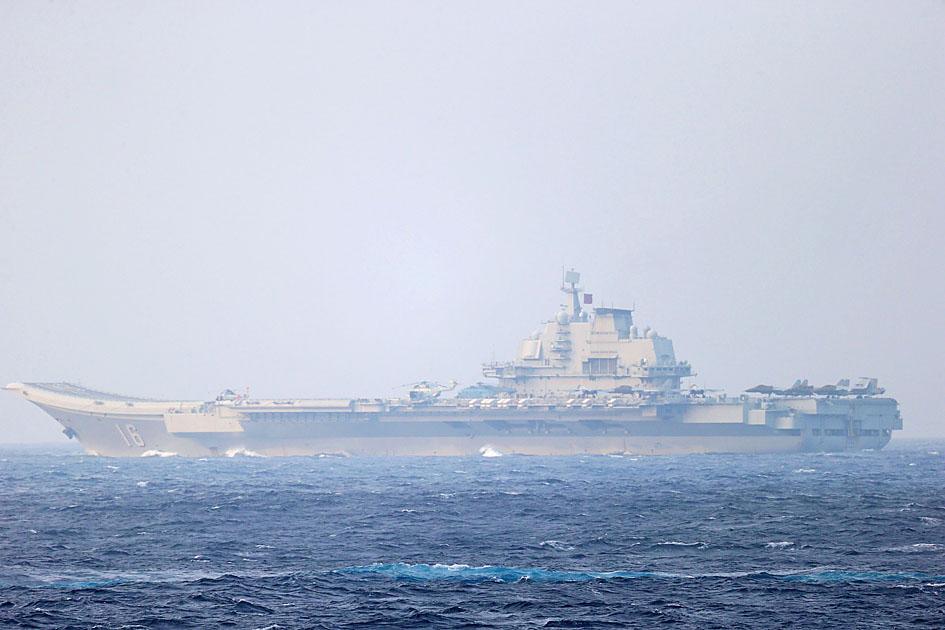The Ministry of National Defense yesterday said it is monitoring Chinese People’s Liberation Army (PLA) Navy ship movements near Taiwan, after the Japanese Ministry of Defense disclosed that Chinese vessels made a rare voyage between Yilan County and Japan’s Yonaguni.
The Japanese ministry on Wednesday said that two Chinese navy ships on Tuesday diverted from their usual route of entering the Pacific Ocean via the Miyako Strait and for the first time traveled there between Yilan and Yonaguni.
The Japan Self-Defense Forces said that it picked up the presence of China’s Type-056A Jiangdao-class corvette 220km north of Yonaguni at 9am on Tuesday.

Photo: Reuters
The vessel met with a Type-052C Luyang II-class destroyer 210km north of the island at 11pm, before together sailing toward the Pacific, it said.
Chinese naval ships usually enter the Pacific through the Miyako Strait — between Japan’s Miyako-jima and Okinawa islands — the Bashi Channel or the Luzon Strait, the latter two of which are between Taiwan and the Philippines.
It is rare for PLA ships to take the route they did on Tuesday, which shows that China is breaking with custom, military observers said.
Meanwhile, two Type 052D Luyang III-class destroyers and two Type 54A Jiangkai II-class guided-missile frigates traveled through the Miyako Strait into the Pacific Ocean, Japan said.
In Taipei, Ministry of National Defense spokesman Major General Sun Li-fang (孫立方) said that Taiwan’s navy closely monitors all Chinese ship movements.
The military is confident, resolved and prepared to safeguard the nation, he added.
The PLA Air Force on Tuesday dispatched 29 jet flights that entered Taiwan’s air defense identification zone (ADIZ), including a Shaanxi Y-9 transport aircraft, a Shaanxi Y-8 transport plane and six Xian H-6 bombers, the ministry said.
The aircraft flew east of Orchid Island (Lanyu, 蘭嶼) and through the ADIZ before returning using the same route.
Compared with previous incursions, this one was a longer-ranged flight, which took the PLA planes closer to Taiwan’s southeastern areas than before, the ministry said.

Auckland rang in 2026 with a downtown fireworks display launched from New Zealand’s tallest structure, Sky Tower, making it the first major city to greet the new year at a celebration dampened by rain, while crowds in Taipei braved the elements to watch Taipei 101’s display. South Pacific countries are the first to bid farewell to 2025. Clocks struck midnight in Auckland, with a population of 1.7 million, 18 hours before the famous ball was to drop in New York’s Times Square. The five-minute display involved 3,500 fireworks launched from the 240m Sky Tower. Smaller community events were canceled across New Zealand’s

The Ministry of Foreign Affairs (MOFA) yesterday said it is closely monitoring developments in Venezuela, and would continue to cooperate with democratic allies and work together for regional and global security, stability, and prosperity. The remarks came after the US on Saturday launched a series of airstrikes in Venezuela and kidnapped Venezuelan President Nicolas Maduro, who was later flown to New York along with his wife. The pair face US charges related to drug trafficking and alleged cooperation with gangs designated as terrorist organizations. Maduro has denied the allegations. The ministry said that it is closely monitoring the political and economic situation

‘SLICING METHOD’: In the event of a blockade, the China Coast Guard would intercept Taiwanese ships while its navy would seek to deter foreign intervention China’s military drills around Taiwan this week signaled potential strategies to cut the nation off from energy supplies and foreign military assistance, a US think tank report said. The Chinese People’s Liberation Army (PLA) conducted what it called “Justice Mission 2025” exercises from Monday to Tuesday in five maritime zones and airspace around Taiwan, calling them a warning to “Taiwanese independence” forces. In a report released on Wednesday, the Institute for the Study of War said the exercises effectively simulated blocking shipping routes to major port cities, including Kaohsiung, Keelung and Hualien. Taiwan would be highly vulnerable under such a blockade, because it

UNRELENTING: China attempted cyberattacks on Taiwan’s critical infrastructure 2.63 million times per day last year, up from 1.23 million in 2023, the NSB said China’s cyberarmy has long engaged in cyberattacks against Taiwan’s critical infrastructure, employing diverse and evolving tactics, the National Security Bureau (NSB) said yesterday, adding that cyberattacks on critical energy infrastructure last year increased 10-fold compared with the previous year. The NSB yesterday released a report titled Analysis on China’s Cyber Threats to Taiwan’s Critical Infrastructure in 2025, outlining the number of cyberattacks, major tactics and hacker groups. Taiwan’s national intelligence community identified a large number of cybersecurity incidents last year, the bureau said in a statement. China’s cyberarmy last year launched an average of 2.63 million intrusion attempts per day targeting Taiwan’s critical